Sage Liskey's Blog, page 7
October 4, 2017
Eating for Happiness and Health - How Food, Nutrients, and Habits Impact Mood

Happy Healthy Eating is a free mini guide that explores how food and nutrition impact our mood. Included are foods to eat, nutrients to fortify, and ways of controlling eating habits for cultivating happiness and coping with depression. Read the images below or skip to the bottom for a text transcription of the whole guide.
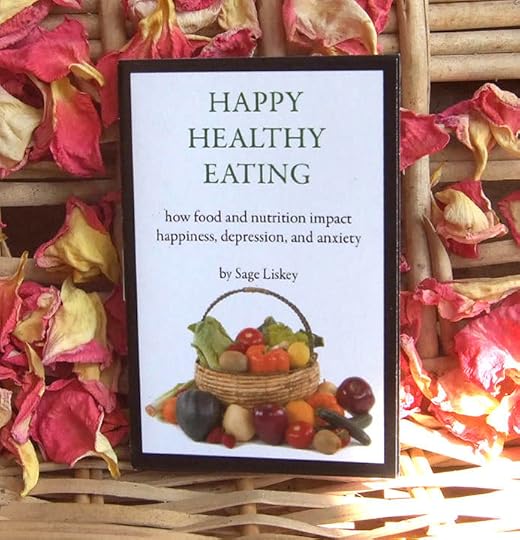
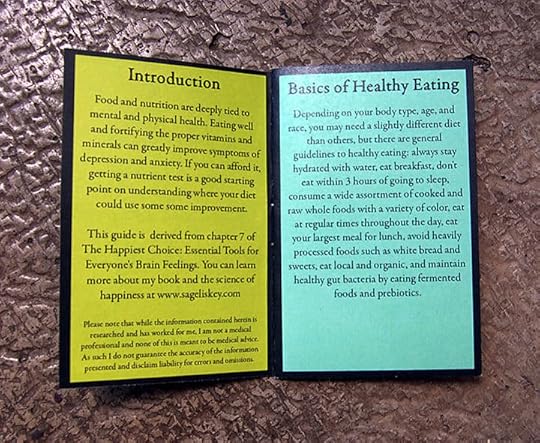

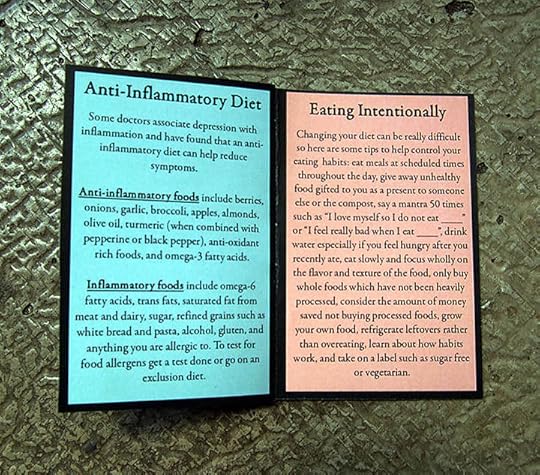 Physical copies are available in our Etsy Shop.or check out our Books and Zines for more empowering and motivational guides. My other mini mental health guides include Happy Healthy Suffering, Happy Healthy Habits, and Happy Healthy Checklist.
Physical copies are available in our Etsy Shop.or check out our Books and Zines for more empowering and motivational guides. My other mini mental health guides include Happy Healthy Suffering, Happy Healthy Habits, and Happy Healthy Checklist.Transcription
Introduction
Food and nutrition are deeply tied to mental and physical health. Eating well and fortifying the proper vitamins and minerals can greatly improve symptoms of depression and anxiety. If you can afford it, getting a nutrient test is a good starting point on understanding where your diet could use some some improvement.
This guide is derived from chapter 7 of The Happiest Choice: Essential Tools for Everyone's Brain Feelings. You can learn more about my book and the science of happiness at www.sageliskey.com
Please note that while the information contained herein is researched and has worked for me, I am not a medical professional and none of this is meant to be medical advice. As such I do not guarantee the accuracy of the information presented and disclaim liability for errors and omissions.
Basics of Healthy Eating
Depending on your body type, age, and race, you may need a slightly different diet than others, but there are general guidelines to healthy eating: always stay hydrated with water, eat breakfast, don't eat within 3 hours of going to sleep, consume a wide assortment of cooked and raw whole foods with a variety of color, eat at regular times throughout the day, eat your largest meal for lunch, avoid heavily processed foods such as white bread and sweets, eat local and organic, and maintain healthy gut bacteria by eating fermented foods and prebiotics.
Nutrients to Fortify for Anxiety and Depression
Deficiencies that may increase the chance of experiencing depression or anxiety include vitamins B1, B2, B6, B9, B12, C, and D, as well as Calcium, Iron, Magnesium, Phosphorus, Potassium, Omega-3 Fatty Acid, Selenium, and Zinc.
Of these, three of the most common deficiencies that people fortify in their diet are Vitamin D, Vitamin B12, and Omega-3 Fatty Acid.
Vitamin D is synthesized when sunlight strikes the skin between 10AM and 3PM but may be blocked by clothing, sunscreen, clouds, and even the atmosphere during winter in latitudes above 37 degrees, It is also in fish and a less potent form, D2, is in some plants.
Vitamin B12 only reliably comes from animal sources unless supplemented. It loses efficacy in light, oxygen, and acid or alkali environments, and may be lost in water or meat juices in cooking.
Omega-3 Fatty Acid has a whole range of health benefits and is found in flax seeds, fish, walnuts, and soybeans. It is heat sensitive and is best fortified while reducing your consumption of omega-6 fatty acids from fats like corn, safflower, sunflower, and canola oils.
Anti-Inflammatory Diet
Some doctors associate depression with inflammation and have found that an anti-inflammatory diet can help reduce symptoms.
Anti-inflammatory foods include berries, onions, garlic, broccoli, apples, almonds, olive oil, turmeric (when combined with pepperine or black pepper), anti-oxidant rich foods, and omega-3 fatty acids.
Inflammatory foods include omega-6 fatty acids, trans fats, saturated fat from meat and dairy, sugar, refined grains such as white bread and pasta, alcohol, gluten, and anything you are allergic to. To test for food allergens get a test done or go on an exclusion diet.
Eating Intentionally
Changing your diet can be really difficult so here are some tips to help control your eating habits: eat meals at scheduled times throughout the day, give away unhealthy food gifted to you as a present to someone else or the compost, say a mantra 50 times such as “I love myself so I do not eat ____” or “I feel really bad when I eat ____”, drink water especially if you feel hungry after you recently ate, eat slowly and focus wholly on the flavor and texture of the food, only buy whole foods which have not been heavily processed, consider the amount of money saved not buying processed foods, grow your own food, refrigerate leftovers rather than overeating, learn about how habits work, and take on a label such as sugar free or vegetarian.

Published on October 04, 2017 22:53
September 25, 2017
A Free Short Guide for Understanding the Causes of Depression and Negative Feelings
Happy Healthy Suffering is a mini zine that explores what causes depression and other forms of mental suffering. It is written from chapters 4 and 5 of The Happiest Choice: Essential Tools for Everyone's Brain Feelings.



 Physical copies are available to purchase on the Rad Cat Press Etsy store.
Physical copies are available to purchase on the Rad Cat Press Etsy store.
Transcription
Introduction
Over the course of a lifetime, mental suffering, depression, and anxiety impacts everyone. They are rampant conditions that are partially biological but largely cultural and an outcome of the society we live in. An important aspect of addressing depression and anxiety correctly is understanding what causes it uniquely in each individual.
This guide is derived from chapters 4 and 5 of The Happiest Choice: Essential Tools for Everyone's Brain Feelings. You can learn more about my book and the science of happiness at www.sageliskey.com
Please note that while the information contained herein is researched and has worked for me, I am not a medical professional and none of this is meant to be medical advice. As such I do not guarantee the accuracy of the information presented and disclaim liability for errors and omissions.
What is Depression?
Clinically speaking depression involves having a certain number of mental and physical symptoms for over 2 weeks. These include feeling sad, being hopeless, anxious, irritable, or guilty, losing interest in a favorite activity, feeling tired, having trouble concentrating, overeating or lacking an appetite, sleeping too much or too little, having thoughts of suicide or suicide attempts, and aches or pains, headaches, cramps, or digestive problems.
In general, depression is simply an extended state of mental suffering caused by “potentials” and “triggers.” “Potentials” increase the likelihood of experiencing depression, and “triggers” put a person into a mental state of suffering.
Potentials
Chemical Abnormalities
hormones, genes, nutrient processing, chemical processing, medications
Life Events
trauma, childhood events, growing up poor, discrimination, exposure to certain harmful chemicals, cultural upbringing
Lifestyle Choices
food, exercise, nutrition, environment, thinking patterns, communication style
Unmet Needs
sustenance, safety, love, empathy, recreation and play, community, creativity, autonomy, and purpose
Triggers
Anything can trigger depression or a mental state of suffering, but some triggers are more common than others such as:
Stress or stressful events, lack of sleep, thoughts, under or over consuming food, consumption of certain substances, media, loneliness, staying inside, withdrawal symptoms, an inability to cope with societal pressures, or expectations that a culture places on members of that culture.
A “potential” can act as a “trigger” with factors like sleeplessness and malnourishment.
My Mind
Adapted from the Icarus Project's 'Mad Map.' Use this template to record your “Potentials,” your “Triggers,” things that make you feel better, and people who can support you when you're having a rough time.
My Potentials
My Triggers
Things That Make Me Feel Better
People Who Can Support Me During An Unhappy Time
On Western Medicine
Medication is the best answer to some forms of mental suffering and help many people cope. Discretion needs to be used however as unlike what many doctors and pharmaceutical companies say, is not always the solution nor is it always safe to consume. Antidepressants can worsen symptoms and in some people simply have a placebo effect. When doctors are prescribing antidepressants they rarely test for the specific chemical or genetic abnormality causing a person's depression or anxiety and instead use a “guess and check” method for prescription. Doctors also tend to ignore the possibilities of nutrient deficiencies, trauma, diet, sleeplessness, lack of exercise, environment, chemical exposure, and so forth. Medication can be healing, just know your options and practice good self-care!




 Physical copies are available to purchase on the Rad Cat Press Etsy store.
Physical copies are available to purchase on the Rad Cat Press Etsy store.Transcription
Introduction
Over the course of a lifetime, mental suffering, depression, and anxiety impacts everyone. They are rampant conditions that are partially biological but largely cultural and an outcome of the society we live in. An important aspect of addressing depression and anxiety correctly is understanding what causes it uniquely in each individual.
This guide is derived from chapters 4 and 5 of The Happiest Choice: Essential Tools for Everyone's Brain Feelings. You can learn more about my book and the science of happiness at www.sageliskey.com
Please note that while the information contained herein is researched and has worked for me, I am not a medical professional and none of this is meant to be medical advice. As such I do not guarantee the accuracy of the information presented and disclaim liability for errors and omissions.
What is Depression?
Clinically speaking depression involves having a certain number of mental and physical symptoms for over 2 weeks. These include feeling sad, being hopeless, anxious, irritable, or guilty, losing interest in a favorite activity, feeling tired, having trouble concentrating, overeating or lacking an appetite, sleeping too much or too little, having thoughts of suicide or suicide attempts, and aches or pains, headaches, cramps, or digestive problems.
In general, depression is simply an extended state of mental suffering caused by “potentials” and “triggers.” “Potentials” increase the likelihood of experiencing depression, and “triggers” put a person into a mental state of suffering.
Potentials
Chemical Abnormalities
hormones, genes, nutrient processing, chemical processing, medications
Life Events
trauma, childhood events, growing up poor, discrimination, exposure to certain harmful chemicals, cultural upbringing
Lifestyle Choices
food, exercise, nutrition, environment, thinking patterns, communication style
Unmet Needs
sustenance, safety, love, empathy, recreation and play, community, creativity, autonomy, and purpose
Triggers
Anything can trigger depression or a mental state of suffering, but some triggers are more common than others such as:
Stress or stressful events, lack of sleep, thoughts, under or over consuming food, consumption of certain substances, media, loneliness, staying inside, withdrawal symptoms, an inability to cope with societal pressures, or expectations that a culture places on members of that culture.
A “potential” can act as a “trigger” with factors like sleeplessness and malnourishment.
My Mind
Adapted from the Icarus Project's 'Mad Map.' Use this template to record your “Potentials,” your “Triggers,” things that make you feel better, and people who can support you when you're having a rough time.
My Potentials
My Triggers
Things That Make Me Feel Better
People Who Can Support Me During An Unhappy Time
On Western Medicine
Medication is the best answer to some forms of mental suffering and help many people cope. Discretion needs to be used however as unlike what many doctors and pharmaceutical companies say, is not always the solution nor is it always safe to consume. Antidepressants can worsen symptoms and in some people simply have a placebo effect. When doctors are prescribing antidepressants they rarely test for the specific chemical or genetic abnormality causing a person's depression or anxiety and instead use a “guess and check” method for prescription. Doctors also tend to ignore the possibilities of nutrient deficiencies, trauma, diet, sleeplessness, lack of exercise, environment, chemical exposure, and so forth. Medication can be healing, just know your options and practice good self-care!

Published on September 25, 2017 12:53
Happy Healthy Suffering - A Short Guide for Understanding the Causes of Depression and Negative Feelings
Happy Healthy Suffering is a mini zine that explores what causes depression and other forms of mental suffering. It is written from chapters 4 and 5 of The Happiest Choice: Essential Tools for Everyone's Brain Feelings.



 Physical copies are available to purchase on the Rad Cat Press Etsy store.
Physical copies are available to purchase on the Rad Cat Press Etsy store.
Transcription
Introduction
Over the course of a lifetime, mental suffering, depression, and anxiety impacts everyone. They are rampant conditions that are partially biological but largely cultural and an outcome of the society we live in. An important aspect of addressing depression and anxiety correctly is understanding what causes it uniquely in each individual.
This guide is derived from chapters 4 and 5 of The Happiest Choice: Essential Tools for Everyone's Brain Feelings. You can learn more about my book and the science of happiness at www.sageliskey.com
Please note that while the information contained herein is researched and has worked for me, I am not a medical professional and none of this is meant to be medical advice. As such I do not guarantee the accuracy of the information presented and disclaim liability for errors and omissions.
What is Depression?
Clinically speaking depression involves having a certain number of mental and physical symptoms for over 2 weeks. These include feeling sad, being hopeless, anxious, irritable, or guilty, losing interest in a favorite activity, feeling tired, having trouble concentrating, overeating or lacking an appetite, sleeping too much or too little, having thoughts of suicide or suicide attempts, and aches or pains, headaches, cramps, or digestive problems.
In general, depression is simply an extended state of mental suffering caused by “potentials” and “triggers.” “Potentials” increase the likelihood of experiencing depression, and “triggers” put a person into a mental state of suffering.
Potentials
Chemical Abnormalities
hormones, genes, nutrient processing, chemical processing, medications
Life Events
trauma, childhood events, growing up poor, discrimination, exposure to certain harmful chemicals, cultural upbringing
Lifestyle Choices
food, exercise, nutrition, environment, thinking patterns, communication style
Unmet Needs
sustenance, safety, love, empathy, recreation and play, community, creativity, autonomy, and purpose
Triggers
Anything can trigger depression or a mental state of suffering, but some triggers are more common than others such as:
Stress or stressful events, lack of sleep, thoughts, under or over consuming food, consumption of certain substances, media, loneliness, staying inside, withdrawal symptoms, an inability to cope with societal pressures, or expectations that a culture places on members of that culture.
A “potential” can act as a “trigger” with factors like sleeplessness and malnourishment.
My Mind
Adapted from the Icarus Project's 'Mad Map.' Use this template to record your “Potentials,” your “Triggers,” things that make you feel better, and people who can support you when you're having a rough time.
My Potentials
My Triggers
Things That Make Me Feel Better
People Who Can Support Me During An Unhappy Time
On Western Medicine
Medication is the best answer to some forms of mental suffering and help many people cope. Discretion needs to be used however as unlike what many doctors and pharmaceutical companies say, is not always the solution nor is it always safe to consume. Antidepressants can worsen symptoms and in some people simply have a placebo effect. When doctors are prescribing antidepressants they rarely test for the specific chemical or genetic abnormality causing a person's depression or anxiety and instead use a “guess and check” method for prescription. Doctors also tend to ignore the possibilities of nutrient deficiencies, trauma, diet, sleeplessness, lack of exercise, environment, chemical exposure, and so forth. Medication can be healing, just know your options and practice good self-care!



 Physical copies are available to purchase on the Rad Cat Press Etsy store.
Physical copies are available to purchase on the Rad Cat Press Etsy store.Transcription
Introduction
Over the course of a lifetime, mental suffering, depression, and anxiety impacts everyone. They are rampant conditions that are partially biological but largely cultural and an outcome of the society we live in. An important aspect of addressing depression and anxiety correctly is understanding what causes it uniquely in each individual.
This guide is derived from chapters 4 and 5 of The Happiest Choice: Essential Tools for Everyone's Brain Feelings. You can learn more about my book and the science of happiness at www.sageliskey.com
Please note that while the information contained herein is researched and has worked for me, I am not a medical professional and none of this is meant to be medical advice. As such I do not guarantee the accuracy of the information presented and disclaim liability for errors and omissions.
What is Depression?
Clinically speaking depression involves having a certain number of mental and physical symptoms for over 2 weeks. These include feeling sad, being hopeless, anxious, irritable, or guilty, losing interest in a favorite activity, feeling tired, having trouble concentrating, overeating or lacking an appetite, sleeping too much or too little, having thoughts of suicide or suicide attempts, and aches or pains, headaches, cramps, or digestive problems.
In general, depression is simply an extended state of mental suffering caused by “potentials” and “triggers.” “Potentials” increase the likelihood of experiencing depression, and “triggers” put a person into a mental state of suffering.
Potentials
Chemical Abnormalities
hormones, genes, nutrient processing, chemical processing, medications
Life Events
trauma, childhood events, growing up poor, discrimination, exposure to certain harmful chemicals, cultural upbringing
Lifestyle Choices
food, exercise, nutrition, environment, thinking patterns, communication style
Unmet Needs
sustenance, safety, love, empathy, recreation and play, community, creativity, autonomy, and purpose
Triggers
Anything can trigger depression or a mental state of suffering, but some triggers are more common than others such as:
Stress or stressful events, lack of sleep, thoughts, under or over consuming food, consumption of certain substances, media, loneliness, staying inside, withdrawal symptoms, an inability to cope with societal pressures, or expectations that a culture places on members of that culture.
A “potential” can act as a “trigger” with factors like sleeplessness and malnourishment.
My Mind
Adapted from the Icarus Project's 'Mad Map.' Use this template to record your “Potentials,” your “Triggers,” things that make you feel better, and people who can support you when you're having a rough time.
My Potentials
My Triggers
Things That Make Me Feel Better
People Who Can Support Me During An Unhappy Time
On Western Medicine
Medication is the best answer to some forms of mental suffering and help many people cope. Discretion needs to be used however as unlike what many doctors and pharmaceutical companies say, is not always the solution nor is it always safe to consume. Antidepressants can worsen symptoms and in some people simply have a placebo effect. When doctors are prescribing antidepressants they rarely test for the specific chemical or genetic abnormality causing a person's depression or anxiety and instead use a “guess and check” method for prescription. Doctors also tend to ignore the possibilities of nutrient deficiencies, trauma, diet, sleeplessness, lack of exercise, environment, chemical exposure, and so forth. Medication can be healing, just know your options and practice good self-care!
Published on September 25, 2017 12:53
September 22, 2017
Art Philosophy
ART Philosophy is an illustrated mini-zine that explores the power of art.



 Available in the Rad Cat Press Etsy Shop.
Available in the Rad Cat Press Etsy Shop.
Transcription
ART
is an expression
Art
connects the artist
to the
subconscious
universe
god
Art
transforms the realty
of the
witness
The highest forms of
art
fill all sensation
with a new world of
possibility
When the body fills with
art
inside and out,
transcendence
of
space and time
takes place
and reality blurs into
beauty
The
artist and
witness
are enlightened,
and god is there
with you
smiling



 Available in the Rad Cat Press Etsy Shop.
Available in the Rad Cat Press Etsy Shop.Transcription
ART
is an expression
Art
connects the artist
to the
subconscious
universe
god
Art
transforms the realty
of the
witness
The highest forms of
art
fill all sensation
with a new world of
possibility
When the body fills with
art
inside and out,
transcendence
of
space and time
takes place
and reality blurs into
beauty
The
artist and
witness
are enlightened,
and god is there
with you
smiling
Published on September 22, 2017 07:12
September 20, 2017
Soulular Potential



 This 6 page mini-booklet is available at www.etsy.com/shop/radcatpress along with other empowering mental health reminders.
This 6 page mini-booklet is available at www.etsy.com/shop/radcatpress along with other empowering mental health reminders.Transcription
Humans are born
with a soul.
When nothing impedes their way,
the soul's personality may manifest fully
into the human presence.
The soul is often hindered by
media consumption, news, unrequited feelings,
fears, too many to-dos, addictions,
and notions of absolute truth in
right, wrong, good, and evil.
The soul is released with
play, emotion, meditation, presence,
connecting to basic human needs,
being in nature, growing food, love, art,
knowing the pinnacles of darkness and depths of light,
and silence.
Humans at one with their soul
attract bountiful beauty,
serendipitous surprises,
and galactic gifts.
Won't you please
free your soul?
Published on September 20, 2017 10:14
September 11, 2017
Happy Healthy Habits Mini Zine for Empowerment and Coping With Depression


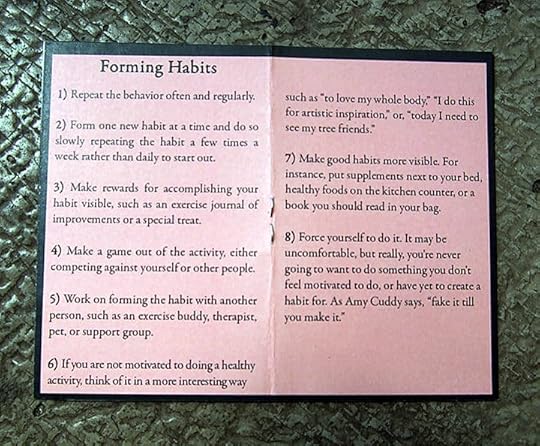
 This 6 page mini-booklet is available for purchase at www.etsy.com/shop/radcatpress along with several other quick mental-health guides.
This 6 page mini-booklet is available for purchase at www.etsy.com/shop/radcatpress along with several other quick mental-health guides. Introduction
Habits allow us to learn an action so well that we don't have to think about how to do it, freeing up our consciousness for other tasks. This is often beneficial to our survival and happiness, but not always. The following is meant to help you understand how to transform unhealthy or destructive habits and form healthy and uplifting ones.
This guide is derived from chapter 5 of The Happiest Choice: Essential Tools for Everyone's Brain Feelings. You can learn more about my book and the science of happiness at www.sageliskey.com
Please note that while the information contained herein is researched and has worked for me, I am not a medical professional and none of this is meant to be medical advice. As such I do not guarantee the accuracy of the information presented and disclaim liability for errors and omissions.
What Is A Habit?
According to Charles Duhigg, habits can be broken down into three parts:
Habit Cue - The sights, smells, flavors, sounds, feelings, and memories that initiate the desire to act out a habit. These you can be aware of.
Habit Action - The habit itself. The brain automates these unconsciously so your thoughts are free to perform other tasks.
Habit Reward - The chemical reward your brain gives you for completing a habit.
Example - The smell of cookies (cue) leads you to buy and eat a cookie (action) which gives your brain a dopamine high (reward).
Forming Habits
1) Repeat the behavior often and regularly.
2) Form one new habit at a time and do so slowly repeating the habit a few times a week rather than daily to start out.
3) Make rewards for accomplishing your habit visible, such as an exercise journal of improvements or a special treat.
4) Make a game out of the activity, either competing against yourself or other people.
5) Work on forming the habit with another person, such as an exercise buddy, therapist, pet, or support group.
6) If you are not motivated to doing a healthy activity, think of it in a more interesting way such as “to love my whole body,” “I do this for artistic inspiration,” or, “today I need to see my tree friends.”
7) Make good habits more visible. For instance, put supplements next to your bed, healthy foods on the kitchen counter, or a book you should read in your bag.
8) Force yourself to do it. It may be uncomfortable, but really, you're never going to want to do something you don't feel motivated to do, or have yet to create a habit for. As Amy Cuddy says, “fake it till you make it.”
Deforming Habits
1) Recognize the habit cues and rewards for a given habit.
2) If a habit cue such as stress or seeing junk food causes you to perform an unhealthy habit, train yourself to perform a healthy habit when you receive those habit cues instead.
3) Remove unhealthy habit cues such as toxic friends and living environments.
4) Break habit cues by changing your environment. The easiest way to change a habit is by doing so on vacation.
5) Put the habit just a little further out of reach so you think twice before initiating it. Block websites and hide addicting food.
Eating Intentionally
1) Eat meals at scheduled times.
2) Give away unhealthy food gifted to you as a present to someone else or the compost.
3) Say a mantra 50 times such as “I love myself so I do not eat ____.”
4) Drink water, especially if you feel hungry after you recently ate.
5) Eat slowly and savor the flavor.
6) Only buy whole foods which have not been heavily processed.
7) Consider the amount of money saved not buying processed foods.
8) Grow your own food.
9) Refrigerate leftovers rather than overeating.
10) Take on a label such as sugar free or vegetarian.
Published on September 11, 2017 08:20
Happy Healthy Habits Minizine for Empowerment and Coping With Depression
Happy Healthy Habits is a short guide on forming and deforming habits displayed below as pictures. Physical copies are available at www.etsy.com/shop/radcatpress. If you'd rather read plain text the transcription is located at the end of this post. Good luck! 



Introduction
Habits allow us to learn an action so well that we don't have to think about how to do it, freeing up our consciousness for other tasks. This is often beneficial to our survival and happiness, but not always. The following is meant to help you understand how to transform unhealthy or destructive habits and form healthy and uplifting ones.
This guide is derived from chapter 5 of The Happiest Choice: Essential Tools for Everyone's Brain Feelings. You can learn more about my book and the science of happiness at www.sageliskey.com
Please note that while the information contained herein is researched and has worked for me, I am not a medical professional and none of this is meant to be medical advice. As such I do not guarantee the accuracy of the information presented and disclaim liability for errors and omissions.
What Is A Habit?
According to Charles Duhigg, habits can be broken down into three parts:
Habit Cue - The sights, smells, flavors, sounds, feelings, and memories that initiate the desire to act out a habit. These you can be aware of.
Habit Action - The habit itself. The brain automates these unconsciously so your thoughts are free to perform other tasks.
Habit Reward - The chemical reward your brain gives you for completing a habit.
Example - The smell of cookies (cue) leads you to buy and eat a cookie (action) which gives your brain a dopamine high (reward).
Forming Habits
1) Repeat the behavior often and regularly.
2) Form one new habit at a time and do so slowly repeating the habit a few times a week rather than daily to start out.
3) Make rewards for accomplishing your habit visible, such as an exercise journal of improvements or a special treat.
4) Make a game out of the activity, either competing against yourself or other people.
5) Work on forming the habit with another person, such as an exercise buddy, therapist, pet, or support group.
6) If you are not motivated to doing a healthy activity, think of it in a more interesting way such as “to love my whole body,” “I do this for artistic inspiration,” or, “today I need to see my tree friends.”
7) Make good habits more visible. For instance, put supplements next to your bed, healthy foods on the kitchen counter, or a book you should read in your bag.
8) Force yourself to do it. It may be uncomfortable, but really, you're never going to want to do something you don't feel motivated to do, or have yet to create a habit for. As Amy Cuddy says, “fake it till you make it.”
Deforming Habits
1) Recognize the habit cues and rewards for a given habit.
2) If a habit cue such as stress or seeing junk food causes you to perform an unhealthy habit, train yourself to perform a healthy habit when you receive those habit cues instead.
3) Remove unhealthy habit cues such as toxic friends and living environments.
4) Break habit cues by changing your environment. The easiest way to change a habit is by doing so on vacation.
5) Put the habit just a little further out of reach so you think twice before initiating it. Block websites and hide addicting food.
Eating Intentionally
1) Eat meals at scheduled times.
2) Give away unhealthy food gifted to you as a present to someone else or the compost.
3) Say a mantra 50 times such as “I love myself so I do not eat ____.”
4) Drink water, especially if you feel hungry after you recently ate.
5) Eat slowly and savor the flavor.
6) Only buy whole foods which have not been heavily processed.
7) Consider the amount of money saved not buying processed foods.
8) Grow your own food.
9) Refrigerate leftovers rather than overeating.
10) Take on a label such as sugar free or vegetarian.




Introduction
Habits allow us to learn an action so well that we don't have to think about how to do it, freeing up our consciousness for other tasks. This is often beneficial to our survival and happiness, but not always. The following is meant to help you understand how to transform unhealthy or destructive habits and form healthy and uplifting ones.
This guide is derived from chapter 5 of The Happiest Choice: Essential Tools for Everyone's Brain Feelings. You can learn more about my book and the science of happiness at www.sageliskey.com
Please note that while the information contained herein is researched and has worked for me, I am not a medical professional and none of this is meant to be medical advice. As such I do not guarantee the accuracy of the information presented and disclaim liability for errors and omissions.
What Is A Habit?
According to Charles Duhigg, habits can be broken down into three parts:
Habit Cue - The sights, smells, flavors, sounds, feelings, and memories that initiate the desire to act out a habit. These you can be aware of.
Habit Action - The habit itself. The brain automates these unconsciously so your thoughts are free to perform other tasks.
Habit Reward - The chemical reward your brain gives you for completing a habit.
Example - The smell of cookies (cue) leads you to buy and eat a cookie (action) which gives your brain a dopamine high (reward).
Forming Habits
1) Repeat the behavior often and regularly.
2) Form one new habit at a time and do so slowly repeating the habit a few times a week rather than daily to start out.
3) Make rewards for accomplishing your habit visible, such as an exercise journal of improvements or a special treat.
4) Make a game out of the activity, either competing against yourself or other people.
5) Work on forming the habit with another person, such as an exercise buddy, therapist, pet, or support group.
6) If you are not motivated to doing a healthy activity, think of it in a more interesting way such as “to love my whole body,” “I do this for artistic inspiration,” or, “today I need to see my tree friends.”
7) Make good habits more visible. For instance, put supplements next to your bed, healthy foods on the kitchen counter, or a book you should read in your bag.
8) Force yourself to do it. It may be uncomfortable, but really, you're never going to want to do something you don't feel motivated to do, or have yet to create a habit for. As Amy Cuddy says, “fake it till you make it.”
Deforming Habits
1) Recognize the habit cues and rewards for a given habit.
2) If a habit cue such as stress or seeing junk food causes you to perform an unhealthy habit, train yourself to perform a healthy habit when you receive those habit cues instead.
3) Remove unhealthy habit cues such as toxic friends and living environments.
4) Break habit cues by changing your environment. The easiest way to change a habit is by doing so on vacation.
5) Put the habit just a little further out of reach so you think twice before initiating it. Block websites and hide addicting food.
Eating Intentionally
1) Eat meals at scheduled times.
2) Give away unhealthy food gifted to you as a present to someone else or the compost.
3) Say a mantra 50 times such as “I love myself so I do not eat ____.”
4) Drink water, especially if you feel hungry after you recently ate.
5) Eat slowly and savor the flavor.
6) Only buy whole foods which have not been heavily processed.
7) Consider the amount of money saved not buying processed foods.
8) Grow your own food.
9) Refrigerate leftovers rather than overeating.
10) Take on a label such as sugar free or vegetarian.
Published on September 11, 2017 08:20
August 1, 2017
New Title! The Motivation To Write: with an abridged history of writing
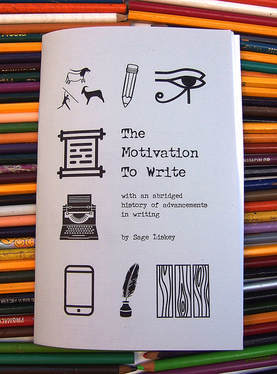 Ever get writer's block? Learn 21 quick tips for staying motivated writing and creating in this humorous new booklet. Includes an abridged history of advancements in language and tools used in writing. Only $5.00 and includes free shipping on the Rad Cat Press Etsy store www.etsy.com/shop/radcatpress
Ever get writer's block? Learn 21 quick tips for staying motivated writing and creating in this humorous new booklet. Includes an abridged history of advancements in language and tools used in writing. Only $5.00 and includes free shipping on the Rad Cat Press Etsy store www.etsy.com/shop/radcatpressAll images used in this booklet are sourced from the Noun Project and are licensed under Creative Commons Attribution 3.0 Unported. No changes were made to the images. See http://www.sageliskey.com/the-motivation-to-write-image-bibliography.html for more information.
Published on August 01, 2017 12:27
July 5, 2017
Oregon Country Fair Workshops and 20% Off Etsy Discount Code!
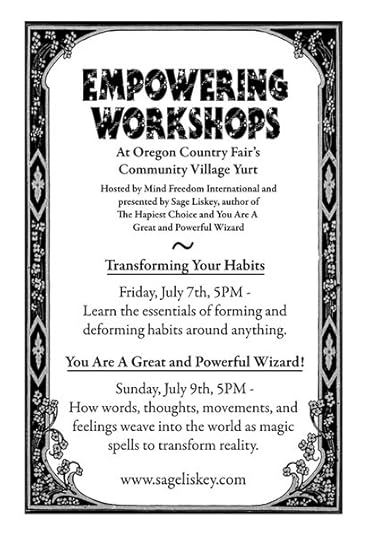 Going to the Oregon Country Fair this weekend? Check out our two workshops! Attendees will receive free resources for cultivating happiness and empowering their lives.
Going to the Oregon Country Fair this weekend? Check out our two workshops! Attendees will receive free resources for cultivating happiness and empowering their lives. Can't make it? Follow us at facebook.com/radcatpress for future workshops or through July type in OCF2017 at checkout while shopping www.etsy.com/shop/radcatpress for 20% off our life-changing books and booklets!
Happy Fair~
Published on July 05, 2017 20:10
May 3, 2017
New poetry section for reading and listening!
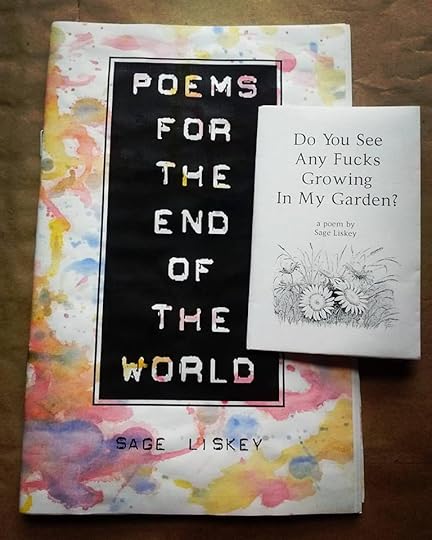 In commemoration of releasing 'Poems for the End of the World' and the mini-zine 'Do You See Any Fucks Growing In My Garden?' I decided to record readings of my poetry and add a new poetry section!
In commemoration of releasing 'Poems for the End of the World' and the mini-zine 'Do You See Any Fucks Growing In My Garden?' I decided to record readings of my poetry and add a new poetry section!You can listen to and read almost all my silly, sad, and cynical poems now, just hop on over:
http://www.sageliskey.com/poetry.html
Might I suggest 'Do You See Any Fucks Growing In My Garden?' (nsfw) http://www.sageliskey.com/…/2017-5-1_do_you_see_any_fucks_g…
'Poems For the End of the World' is also now available for purchase on our Etsy page, each with a unique paint splatter! www.etsy.com/shop/radcatpress
Published on May 03, 2017 10:47



